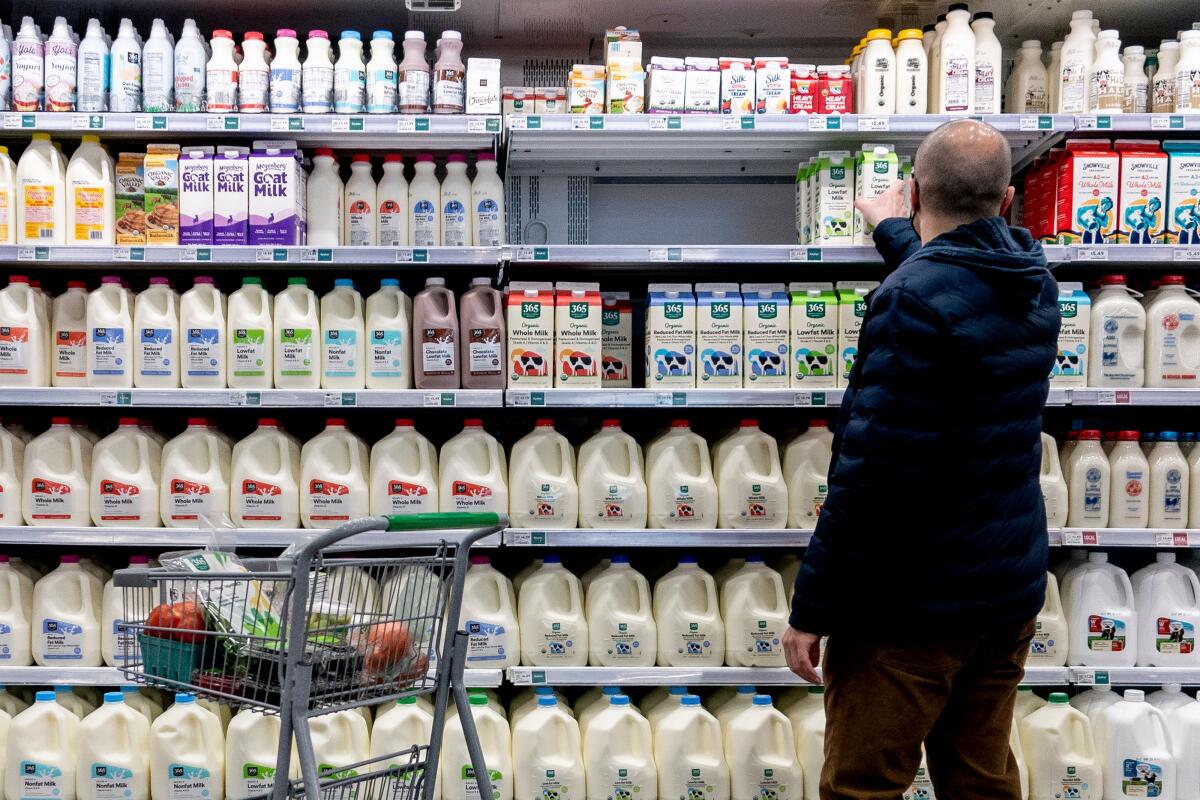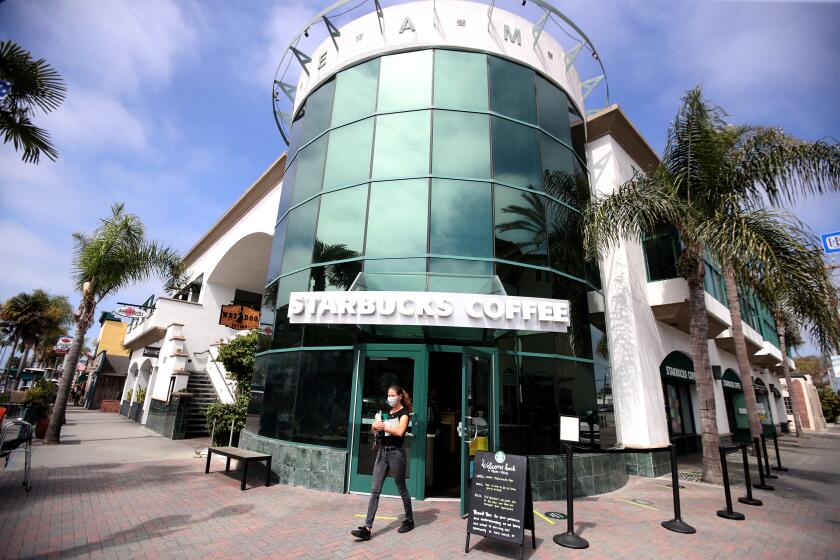Column: You may not have noticed yet, but inflation has started to come down

For fans of code-breaking, Thursday morning’s Wall Street Journal home page provided plenty of material to perplex and entertain.
There was an article documenting a sharp price decline in memory chips, which are essential parts in cars, smartphones and household appliances. Another about declines in shares of fertilizer companies, driven by “falling crop prices.”
Yet a third article reported a narrowed trade gap due to a pullback in the American frenzy for foreign goods. There was also a report that rates on 30-year mortgages had fallen sharply, to 5.3% from 5.7% a week ago.
Get the latest from Michael Hiltzik
Commentary on economics and more from a Pulitzer Prize winner.
You may occasionally receive promotional content from the Los Angeles Times.
Amid all that, as the Journal observed, the minutes of the Federal Reserve Board’s rate-setting meeting released Wednesday suggested that inflation panic drove its decision to raise rates by three-quarters of a percentage point, the largest increase in 28 years.
What’s wrong with this picture?
Signs are proliferating that the inflation rate peaked in February and March. That hasn’t been too visible in the most recent data releases from the Bureau of Labor Statistics but may become evident with the agency’s next report on the consumer price index, due July 13.
The report may show inflation still high, possibly even exceeding the rate of previous months. Economists surveyed by Bloomberg say they expect it to be higher by nearly 9% at an annual rate.
But the inflation report looks back—it’s not a snapshot of inflation in real time. So if inflation really is ebbing, the July 13 report may overstate the current rate.
It’s proper to stipulate that even as inflation ebbs and prices begin to come down, the costs of many goods and commodities remain materially higher than they were a year ago. That means that the pain of the last few months will linger.
The national average price of gasoline, for instance, has been falling for the better part of a month, to an average of $4.75 a gallon for regular, down from $4.92 a month ago, according to AAA. That will bring some relief to motorists, but a year ago the average price of regular gas was $3.14.
Still, the falling pace of price increases suggests that the Fed, which is fixated on inflation and has a tendency to fight the last war, may be misreading the economic environment.
The minutes released Wednesday, along with subsequent statements by Fed Chairman Jerome H. Powell and other Fed governors, indicate that its determination to control inflation is so firm that it’s willing to risk provoking an economic downturn to achieve its goal.
As we’ve observed before, sacrificing jobs in the cause of reducing inflation is a cure worse than the disease. More to the point, it places the burden of monetary policy on the backs of the wrong people. Rank-and-file workers and their wages have not been the drivers of inflation in the last year. Rather, it’s been driven by structural issues in the post-pandemic global supply chain and by corporate actions designed to fatten profits, which are then funneled to executives and shareholders.
Indeed, the principal inflation remedy in the Fed’s medicine chest — raising interest rates — is ineffective against the most important drivers of inflation today. U.S. interest rates have nothing to do with the constraints on supplies of computer chips and other goods and parts resulting from COVID-related factory shutdowns in China. Interest rate increases could do nothing to reduce logjams at U.S. ports that kept shipped products from reaching consumers.
Oil prices, which are set in the global marketplace, are affected by the law of supply and demand, but if Powell and company aim to reduce U.S. demand by stifling the American economy generally, there will be lots of collateral damage in U.S. households for marginal gain, at best.
As for the raw figures, the core consumer price index (that is, excluding food and energy), rose by an annualized 6.5% in March but fell to 6.0% in May. Including food and energy, the index reached 8.54% in March, fell to 8.3% in April and rose back to 8.58% in May. Rounding the figures made it seem as though the index rose from 8.5% to 8.6% from March to May, but obviously the change was smaller.
The Fed’s preferred inflation gauge, the personal consumption expenditures price index or PCE, also peaked several months ago. Its core rate reached 5.3% in February on a year-over-year basis, and fell to 4.7% in May; its all-prices measure hit 6.6% in March and fell to 6.3% in May. The next PCE report from the Bureau of Economic Analysis is scheduled for July 29 and will cover the index for June.
Now let’s look at some price components, which have been helpfully compiled by Barry Ritholtz of Ritholtz Wealth Management and the Big Picture economic blog.
First, oil. The price of benchmark West Texas Intermediate crude has fallen from its recent peak of $122.11 per barrel to less than $104 last Thursday after dipping below $100 the day before. The price was $65.57 on Dec. 1, before it got driven up by Russia’s attack on Ukraine, which started Feb. 24.
Wholesale gas prices experienced what Ian Shephardson of Pantheon Macroeconomics labeled a “meltdown” in commodity trading of about 25% Thursday, presaging “serious relief at the pump” over the next couple of weeks. (Shepherdson says he expects “much lower headline CPI/PCE” figures for July and subsequent months.)
Corporations are raising prices at the fastest rate since 1955, driving inflation higher.
The prices of industrial metals have been plunging, with the Bloomberg index of those commodities falling by 38% since March. That may reflect expectations of a recession, but it could also be the unwinding of investor enthusiasm that had driven prices higher than was warranted.
Ocean shipping rates, as tracked by the supply chain research firm Drewry, have fallen sharply. The cost of shipping a 40-foot container from Shanghai to Los Angeles fell to $7,566 on July 5 from $12,424 in September, down by 40%.
Shipping rates are a reflection of economic activity and strains on the global supply chain, and a driver of inflation. Whether the fall in rates reflects a slowing economy or will help sustain the economy may be hard to know except in a rear-view mirror. In any event, it signals an easing of pressure on prices.
Will these trends continue? Economic policymakers certainly hope so. In part that’s because inflation expectations have the tendency to build on themselves.
“Inflation can be a self-fulfilling prophecy,” Treasury Secretary Janet Yellen warned in November, when there was still hope that price surges would burn themselves out within a few short months. Whether that will be the case now is anyone’s guess.
More to Read
Get the latest from Michael Hiltzik
Commentary on economics and more from a Pulitzer Prize winner.
You may occasionally receive promotional content from the Los Angeles Times.












